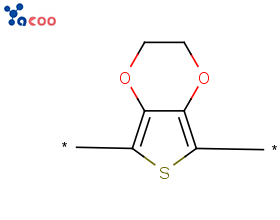2023-10-23
Product Name:Poly(3,4-ethylenedioxythiophene)
English abbreviation:PEDOT
CAS:126213-51-2
Molecular Formula:C6H6O2S
Article No.: J0230
Structural Formula:

Product Introduction
PEDOT is a polymer of EDOT. PEDOT has the characteristics of simple molecular structure, small energy gap, and high conductivity, and is widely used in the research of organic thin film solar cell materials, OLED materials, electrochromic materials, transparent electrode materials, and other fields.
Application of PEDOT
Recently, synthetic resins or fibers have been increasingly used in the fields of semiconductors, electronics, and display devices, leading to troublesome and unresolved electrostatic problems. At present, the adhesive layer has been made antistatic to solve the electrostatic problem generated when separating the release film from the adhesive layer. If the adhesive layer is made antistatic, it may not fully exhibit antistatic performance due to poor compatibility between the antistatic agent and the adhesive. Therefore, in addition to the anti-static properties of the adhesive layer, the release layer has been made anti-static. Conventional antistatic techniques include adding anionic compounds internally, coating with conductive inorganic particles, coating with low molecular weight anionic or cationic compounds, and coating with conductive polymers. However, existing technologies are not cost-effective and have limitations in obtaining anti-static performance. To address this issue, the CN101421104B patent provides an anti-static silicone release coating film. In patented technology, polyanions are acidic polymers, as well as polymeric carboxylic acids or polymeric sulfonic acids, polyethylene sulfonic acids, etc. Examples of polycarboxylic acids include polyacrylic acid, polymethacrylic acid, polymaleic acid, etc. Examples of polymeric sulfonic acid are polystyrene sulfonic acid, etc. Meanwhile, in the present invention, a polymer lotion is used, which comprises 0.5 %weight of poly (3,4-ethylenedioxythiophene) and 0.8% weight of polystyrene sulfonic acid.
The anti-static silicone release film of the present invention is produced through online or offline production processes and used as a release film for semiconductor, electronic, and display devices. Due to its high level of anti-static performance, it can reduce product contamination caused by static electricity when the film is peeled off from the adhesive layer.
References
CN101421104B Antistatic silicone release coating film.
Copyright © Suzhou Yacoo Science Co., Ltd. All Rights Reserved
Friendly Links :
online service